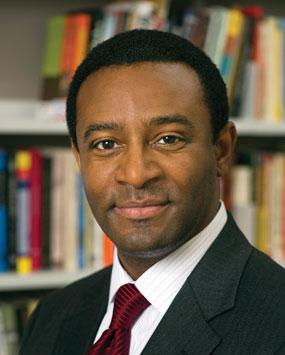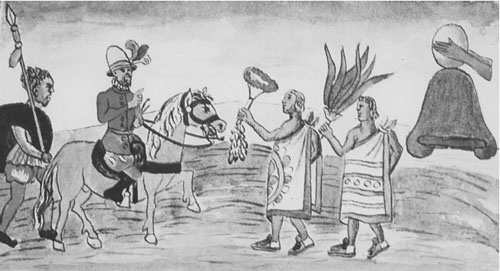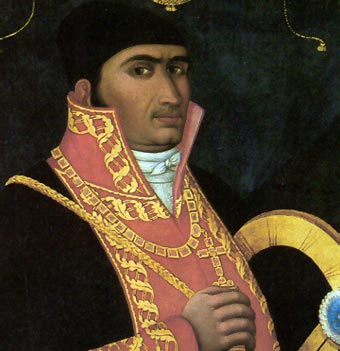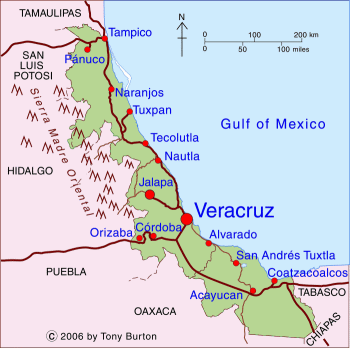Ben Vinson III is a historian at Johns Hopkins University and perhaps the world’s leading scholar on Afro-Mexican history. He has published several books about Afro-Mexicans, including Bearing Arms for His Majesty: The Free-Colored Militia in Colonial Mexico (Stanford, 2001), Flight: The Story of Virgil Richardson, A Tuskegee Airman in Mexico (Palgrave, 2004), and Afroméxico (Fondo de Cultura Economica, 2004). He is also one of the participating scholars in La Bamba: The Afro-Mexican Story, Afropop’s Hip Deep radio documentary all about black history and music.
Here, you can read the full transcript of producer Marlon Bishop’s interview with Professor Vinson. Don’t forget to also check out stories from our travels in Mexico on the Afropop blog and our Afro-Mexico video series.
Marlon Bishop: To start off, what does the term Afro-Mexican mean?
Ben Vinson: That’s a good question. The term "Afro-Mexican" basically refers to people of African descent in Mexico. Usually it refers to people who have colonial origins, who were brought during the slave trade. The term "Afro-Mexican” is actually a little bit contentious, because people tend to think of themselves as Mexican or not. So, inserting kind of a hyphened identity has been problematic, although recently in September 2012, a declaration was made by populations of African descent in Mexico to use the term.
Scholar Ben Vinson
There was another term that was used in Mexico starting in the 1940s – “Afro-Mestizo.” It’s basically another way of thinking about blackness, really blackness packaged in racial mixture. That term was popularized by Gonzalo Aguirre Beltrán, who was one of the great fathers of Afro-Mexican scholarship.
MB: How does the African presence in Mexico begin?
BV: The African presence in Mexico begins with the earliest colonization effort. As the Spaniards arrived in the 1519 to 1520 period, they brought with them African auxiliaries who came with them, in some cases as slaves, and in some cases as field workers, and in other cases, quite frankly, as conquerors.
Drawing of African Conquistador Juan Garrido
One of the great Afro-Mexican conquistadors, or conquerors, was Juan Garrido, a man who actually participated in multiple conquests of the Spanish in the new world, and Mexico was one of his final resting places. So, the history is actually one that is not an exclusive story of slavery; it's one that encompasses freedom and slavery in Mexico from the earliest days of the Spanish arrival.
MB: Take us through the history from there – what happens next?
BV: What happens is that slavery begins to take off a little bit in the 16th century. There's a 70-90 percent decline in the millions of indigenous people that lived throughout Latin America. As this happened, the Spanish crown started looking at alternative labor sources, and the African population was a prime candidate, experimented with first in the Caribbean and then brought to Mexico.
Early Afro-Mexicans worked in a number of industries – in silver mines, as cattle rustlers, as domestics, as well as what we in the US would think of as a more classic slave scene on sugar plantations in Veracruz, and some cotton cultivation on the Pacific coast of Mexico.
The 17th century, things change a little bit. The colonial government finds that they want to cut back on the number of native populations who are engaged in plantation-type labor. They think that it's very, very detrimental to an already falling native population, so they ratchet up the importation of African slaves. That really takes place from about the 1580s until the 1650s, what we call the heyday period of the Mexican slave trade. Roughly one-half of all slaves brought by the Spanish to the new world went to Mexico, the other half pretty much to the Peruvian area. So, we're looking at about 250,000 or so people that we pretty much have a record of – there are probably more – who are brought to Mexico.
MB: After that, slavery kind of slows down in Mexico, no?
BV: Yes, and there are a number of reasons for that. Between 1580 and 1640, the Spanish crown was joined with the Portuguese crown, and the Portuguese held a monopoly over the slave trade. So, they were able to bring in tons of slaves into the new worlds. In 1640, that monopoly ends, so slaves are really coming in through illegal means, through an internal slave trade that lasts really until the mid- to late-18th century.
Slavery doesn't end; it continues, but we start seeing a downturn in the number of peoples of direct African descent coming into Mexico. Really, we see now what is the birth and growth of a mulatto population, or a racially-mixed black population that starts to take preeminence. So much that by 1810 or so, 10 percent of the population of Mexico includes peoples of African descent. That is roughly analogous to the population here in the United States at that time.
MB: In your book, Bearing Arms for His Majesty, you focus on the role of Afro-Mexicans in the colonial military. Tell me about that.
BV: One of the key roles that people of African descent played in Latin America, and particularly in Mexico, was in military service, especially militias. Around the 1550s, we start seeing peoples in African descent entering in fairly decent numbers into militia ranks.
One of the things that I've discovered in researching the militias is that this particular type of affiliation created a structure for peoples of African descent to harmonize, to come together and to develop a sense of identity around the privileges that were given to militia soldiers.
Through the militias, peoples of African descent were able to really defend and obtain favor with the Spanish crown itself for things that they did of importance, such as defending the Viceregal Palace during fires or serving as policemen. In a world where there were no police in the 1700s, these black soldiers basically patrolled the streets and made sure that people were law-abiding citizens.
Peoples of African descent used these militias also to develop local politics. They were able to use their guns and their reputation to challenge the authority of governors and mayors, so this became a very important political venue for peoples of African descent. These are just a few of the ways in which during the colonial period these militias really sedimented an Afro-Mexican identity and really forwarded agendas of the Afro-Mexican presence.
MB: Some of Mexico’s military heroes are said to have been of Afro-Mexican descent, correct?
BV: Certainly, the two most famous are probably José María Morelos, who was one of the freedom fighters during Mexico’s fight for independence. He was a major guerilla fighter that helped liberate Mexico with the assistance of other peoples of African descent in the Pacific region of Mexico. According to rumor, he wore what we might call a stocking cap, really a handkerchief over his head, to hide his curly locks so that people wouldn't see him as someone of African descent
José María Morelos
There was also Vicente Guerrero, who was one of the presidents of Mexico in the late 1820's. In fact, he was responsible for abolishing slavery around 1829. He was another hero of the independence struggle and he, of course, was the person in charge. Barrack Obama 1829, if you will. These are probably two of the greatest heroes and figures in Afro-Mexican history.
MB: So considering how important Afro-Mexicans were in Mexico during all these years, it’s strange how they seem to have disappeared from the national consciousness. How did that happen?
BV: Yes, well first of all, Afro-Mexicans never fully disappear. But what happens is that, beginning in the 1820s when Mexico liberates itself from Spain, there's a new dialogue that starts to arise around citizenry. Native populations became key and were embraced and extolled in the sensibility of the nation.
There's one other thing that I should point out, as well. During the 1800's in particular, there were a number of African-Americans that came to Mexico to colonize in the northern parts of the country. There were a number of peoples from the Caribbean who also came into Mexico to work on the railroad lines and in other industries. What happens is that as these new blacks come in from other parts of the world, they create a convenient mechanism for Mexican politicians, to say that, "We don't have blacks here. These are foreigners.” It's an out for Mexican politicians that they used because, quite frankly, in the 19th century, it wasn't great to depict your country as having peoples of African descent.
Afro-Mexicans never disappeared. And you can find pockets throughout the landscape of the country, but what happens is their political discourse changes, and there are more opportunities for erasing the Afro-Mexican image from portrayals of national identity.
MB: People like Morelos and Guerrero were national heroes, the kind of people who have whole Mexican states named after them, yet their Afro-Mexican heritage has never really been celebrated – why is that?
BV: There's a good reason for that. These people are not necessarily considered to be of African descent because that's not the discourse of the nation. People will talk about citizens before they talk about race. That's something that's held true even into the current period. It's a way in which Mexico and other Latin American nations were able to juxtapose and distinguish themselves from places like the United States that had a "racial problem." These places didn't have racial problems because they didn't include race as part of the equation.
We must also remember that these Afro-Mexican communities were engaged in racial mixture. They had a century or so lead on the United States in this regard and, of course, we know that our laws of segregation also in many ways hindered the abilities for people of African descent to engage in racial mixture. So, in a more open society it becomes possible for Afro-Mexicans to become part of the broader blood pool of the national population.
Today, for example, if you look at the surnames of certain individuals, sometimes you'll see someone named Juan Pardo or Julia Moreno. These are black surnames, literally meaning Juan Brown or Julia Black. Those are clues to possible Afro-Mexican links that go back generations.
MB: So fast-forward to the present, where do we find Afro-Mexicans today?
BV: Today, we find peoples of African descent on the Pacific Coast, in a region south of Acapulco called the Costa Chica, meaning quite literally the Little Coast.
This is an area that until the 1960s or so was, as some have described, a region “forgotten in time.” It's a part of the country that didn't get highways until the 1960s. So, given its isolation and exclusion, this has been a part of the country that has developed its African-descended population from the colonial times with minimal interruption from outside.
The other part of the country where we see a significant Afro-Mexican population is Veracruz, on the Gulf Coast. This is a more complication situation because the peoples of African descent who are here come from both ancestral ties dating back into the colonial period as well as more recent immigration: Afro-Cubans coming in, various Caribbean people coming in through the Port of Veracruz, which was a major thoroughfare for goods and people.
Veracruz
Veracruz is the part of the country that has often been considered black in the Mexican imagination. It's convenient because it plays to that trend that “blacks are foreigners, they come from the outside” Or – “if blacks are not foreigners, they're conveniently contained within this space, within in this particular region, and not to spill over into other parts of the country.”
There are other pockets that you may or may not know of. If you look at the Southern border of Mexico, you'll find peoples of African descent here, too, coming in particularly from Belize. You'll find some very, very thin and scattered pockets of peoples of African descent in the northern reaches of Mexico, the border of the United States, where African-Americans had established colonies in the 19th century. These are faint communities, not so extensive, but they are at least worth giving acknowledgement of.
MB: What do people mean when they use the phrase the “Third Root”?
BV: Beginning in the 1980s, something came about known as the Mexican “Third Root” movement. It was a government-sponsored initiative that sought to look what was called Mexico’s third root, or its black root. It was also looking to acknowledge all of the elements of Mexico's racial mixture. It's important to put out there that Afro-Mexican history was not necessarily being studied only to understand Afro-Mexicans but also to understand how that population intersected into the greater populace.
So, this is a process that began in the 1980s. It started to attract more and more and more attention from scholars, from students and from the greater population on the whole.
MB: What implications does this movement have for Afro-Mexican communities themselves?
BV: One thing that’s been happening is the mobilization of Afro-Mexican communities themselves into political and cultural groups that has been taking place on the west coast of Mexico, notably under the aegis of Padre Glyn Jemmott, a Trinidadian priest who has lived in Mexico for years and has helped sensitize peoples of African descent to their history. This has led to an efflorescence of cultural re-engagement: dance groups, theater groups, radio shows, Afro-Mexican hip hop, lots of other things that are taking place in this particular part of the world and also taking off more and more in the university community. This is a very important trend that's on the current landscape of Mexico at the moment.
MB: Last question – how does all this relate to music?
BV: Of course, one of the things that we have to remember is that all of these populations created culture, so this begins from the moment of disembarkation in Mexico as slaves in the 1500s to contemporary times where peoples of African descent create community and do that around aspects of cultural production.
As culture is created, people go back to their roots, consciously or unconsciously. So, in that sense, this is why aspects of Afro-Mexican culture have been preserved over time because, through repetition and through re-adaptation of cultural practices to contemporary moments, there has been a lineage and survival of Afro-Mexican practices across time. The imprints are faint, but their relevance and their meaning are constantly recreated from colonial into modern times.












